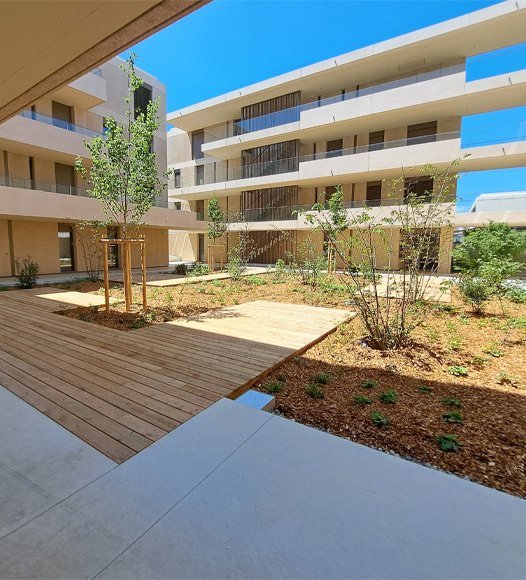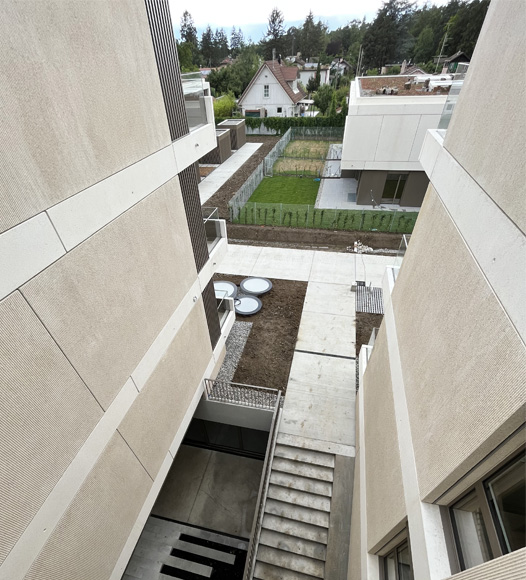The development at Le Parc des Crêts is on a nine-hectare greenfield site in Troinex, a municipality in the Canton of Geneva, and will be completed in 2025. Boccard, a wholly owned Swiss subsidiary of idverde, is responsible for the design and creation of the development, including building long-term sustainability into the project. As a company with a clear ambition to create places where nature and people thrive, this project represents a flagship development for idverde.
Our nature-based solutions approach supports working with the natural environment rather than against it, and this approach is clear in the architecture, building design and planting plans of the development. The design is car-free at ground level, with parking underground, and this has resulted in innovative thinking in terms of water management and flood prevention as the site is bordered on two sides by water (the Drize river and a stream ‘le ruisseau marais’).

A community for everyone
Le Parc des Crêts is a vision for future community, with housing suitable for everyone from young single people through to families and older people.
The whole site is fully accessible, and while there are private gardens, much of the site is communal, with facilities that include a children’s play area, bike storage, BBQ areas, communal seating and a range of both formal and natural planting.
Aligning development with nature
Working alongside the project’s architects, idverde designers have taken inspiration from the flora and fauna that thrives in the landscape around the Salevre geological strata. Looking for innovative ways to create natural outdoor areas, and use planting to improve the environment is central to the development in Troinex.
Set within the Salève foothills, landscaping at the development reflects the forests and boulders, and has also been designed to manage water across the site.
“We are using both local and sustainable materials,” says Arnaud Fauvel, idverde’s Country Director for Switzerland. “The wood is cultivated in the Swiss forests and choice of clay limestone material from Salève is a natural choice for constructing the permeable paths; it is easily available from the local quarry, so significantly reduces our carbon impact.
“All coatings used throughout the project will be permeable, promoting runoff water and limiting the leakage rate when water is discharged into the marsh stream.”
Bringing diverse planting schemes together
Planting has been designed to meet several different requirements. The site will use a lot of tree planting, which gives natural shade, lowers temperatures during the warmer months and provides valuable habitats for wildlife. The trees have been specially cultivated for the project without the use of chemical pesticides in a progressive nursery based in the canton of Geneva. As a result, they will have already adapted to the local climate and the transportation carbon footprint of transportation will be drastically reduced.
The design also includes meadow planting, suitable for the shade created by the surrounding buildings and shrubs. This leads to a high-flowered meadow with wildflowers and grassland that encourages biodiversity, with water planting, wildflowers and ornamental planting. Dedicated vegetable and fruit gardens allow for community gardening and are designed to be completely accessible across the community’s age range.

Connecting areas
On the outskirts of the park, the design includes biological corridors planted with shrubs and trees, connecting the riparian zone of the ‘le ruisseau marais’ stream to the Drize river. Meadows and shrub planting provide the link between this area and the central neighbourhood.
“Less frequented spaces of the park are ideal places for creating habitats for small fauna. This includes the gravel strips surrounding the buildings that are planted with meadow, shrubs and trees, which are very useful for animals. Alongside the dedicated meadows, these spaces offer safe places for flora and fauna to exist alongside people.”
This approach does not stop with the initial construction. Surfaces are designed to be managed extensively to limit maintenance, reducing the need for watering. Flower meadows and extensive green roofs are largely self-managed and the materials used in the district are durable and require little maintenance.
The development is due to open in 2025. idverde is proud to be part of this innovative build where nature and people can thrive together.
Have a question for the idverde group?
Contact idverde group
Do you have a question for a particular park place country? Try these links:







